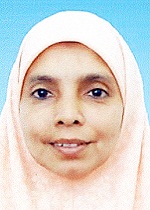Effect of New Fungicides in Controlling Anthracnose/Die Back Disease of Chilli
Keywords:
Abstract
The experiment was conducted in the laboratory and field of Spices Research Centre, BARI, Shibganj, Bogra, Bangladesh during Rabi season of 2014-2015 to test the efficacy of some new fungicides in controlling anthracnose/die-back disease and increase yield of chilli. Nine new fungicides and one control were used as treatments. In vitro tests, Orion 72 WP (0.2%) significantly inhibited the radial mycelial growth of the pathogen (Colletotrichum capsici) in the PDA culture media. All the new fungicides significantly decreased the % leaf infection, % leaf area diseased (LAD), % twig infection, % fruit infection, % fruit area diseased (FAD) and increased fresh yield of chilli. Among the fungicides, Orion 72 WP showed the best performance.
References
Agri Diary. 2012. Agriculture Information Services, Ministry of Agriculture, Khamarbari, Dhaka, Bangladesh.
Anonymous. 1960. Index of Plant Disease in the United States. Agricultural Head Book No. 165. U.S. Department of Agriculture. p.531.
Anonymous. 1966. Index of Plant Virus Disease. Agricultural Head Book No. 307 U.S. Department of Agriculture. p. 446.
Anonymous.2011. KrishiProjuktiHatboi (Handbook on Agro-technology), 5th edition, Bangladesh Agricultural Research Institute, Gazipur 1701, Bangladesh.
Ayub, A. and N.Sultana. 2008. Efficacy of fungicides in controlling die-back of chilli. Plant Pathological Research, Annual Report, 2007-08, Plant Pathology Division, BARI. pp. 72-73.
Barnett, H. L. and B. Hunter. 2000. Illustrated genera of Imperfect Fungi. 4th Ed., Freedom Palestine. p. 218.
Basak, A.B., M.A.U. Mridha and G.A. Fakir. 1989. National Botanical Conference, Chittagong (Bangladesh), 18-19 Jan. p. 6.
Basak, A.B., M.A.U. Mridha and G.A. Fakir. 1991. Studies on different types of fruits rot of chilli occurring in Bangladesh. Bangladesh J. Bot., 20:11-18.
Biswas, A. 1992. Efficacy of fungicides in control of anthracnose disease of chilli in Sondarban region of West Bengal. J. Mycopath. Res. India 30(1): 31-35.
Booth, C. 1971. The genus Fusarium. The Commonwealth Mycological Institute.
Datar, V.V. 1996. Efficacy of growth regulators and fungitoxicants on fruit rot of chilli. Indian J. Mycol. Pl. Pathol. 26 (3): 239-242.
Datar, V.V., M.B. Sontakke, N.D. Purandare and N.N. Shinde. 1990. Fungicidal control of anthracnose of chillies. Indian J. Mycol. Pl. Pathol. 20(2): 156-158.
Ebenezar, E.G. and D. Alice. 1996. Field evaluation of fungicides against fruit rot, powdery mildew and thrips of chilli. J. Maharashtra- Agril. Uni. 18(2): 296-297.
Ekbote, S.D. 2005. Management of chilli fruit rot caused by Colletotrichum capsici. J. Mycol. Pl. Pathol. 35(1): 183.
Ellis, M.B. and J. P. Ellis. 1997. Micro fungi on Land plants. An Identification Handbook. p. 273.
Ellis,M.B.. 1971. Dematiaceous hypomycetes. Commonwealth mycological Institute, England. p.507. DOI: https://doi.org/10.1079/9780851986180.0000
Gomez, K. A. and A. A. Gomez. 1984. Statistical Procedures for Agricultural Research 2nd ed., Intl. Rice Res. Inst., John Willy and Sons, New York, Chichester, Brisbane, Toronto, Singapore. pp. 187-240.
Hedge, G.M. and K. H. Anahosur. 2001. Effect of sodium chloride treatment on the disease development, quality and biochemical constituents of chilli fruits affected by Colletotrichum capsici. Karnataka J. Agril. Sci. 14(3): 681-685.
Howlider, M.A.R., M.B. Meah, M. Jalal Uddin and A. Rahman. 1985. Effect of fungicides in reducing intensity of Alternaria blight of mustard. Bangladesh J. Agric. 10(4): 41-46.
Joshi, M.C. and D.P. Singh. 1975. Chemical composition in Bell pepper. Indian Hort. 20: 19-20.
Kasyap, A., P.K. Tiwari, C.P. Khare and V.S. Thrimurty. 2008. Evaluation of varieties and fungicides against anthracnose and fruit rot of Chilli. J. Plant Protec.Sci.16(1):159-161.
Kumawat, G. L. 1997. Field evaluation of fungicides for control of anthracnose of chilli (Capsicum annuum). Indian Cocoa, Arecanut and Species J. Agril. Res. Sta., 21(3): 71-73.
Mandge, A.S., V.V. Dater and N.N. Shinde, 1993. Chemical management of fruit rot, powdery mildew and thrips of chilli. J. Marashtra Agric. Univ. 18(2): 296-297.
Meah, M.B., M.A.R. Howlider, M. Jalal Uddin and A. Rahman. 1988. Effect of fungicide spray at different time and frequencies on Alternaria blight of mustard. Thai. J. Agric. Sci. 21:101-107.
Mistry, D.S., I.P. Sharma and S.T. Patel. 2008. Evaluation of Fungicides, Phytoextracts and Bio-Pesticides Against Die-Back of Chilli. J. Disease Sci. 3(1): 53-55.
Pardhi, S. and B.T. Raut. 2011. Efficacy of fungicides, bioagents and botanicals against Colletotrichum capsici causing fruit rot of chilli. J. Pl. Disease Sci. 6 (2): 114-116.
Rangaswami, G. 1979. Disease of crop plants in India, Private Ltd. India. p.520.
Romer, P.K., Masutt, Rocha-j-de-jp-da., M.J.C. Rocha, M. Santen-E-van, Wink, Wissmann and P. Romer. 2000. Further trials in control anthracnose (Colletotrichum sp.) in white lupines, an ancient crop for the new millennium: proceedings of the 9th International lupine conference, Klink Muritz, Germany. 40-42.
Shinde, J. U., V. S. Bhadrashette and D. U. Gawai. 2012. Effect of Fungicides on growth of Colletotrichum capsici Butler & Bisby. BIOINFOLET - A Quarterly J. Life Sci. 9(1): 5-6.
Singh, R.S. 1982. Plant Pathogens–The Fungi. Oxford & IBM Publishing Co. New Delhi, India. 564 p.
Sutton, B.C. 1980. The coelomycetes, Fungi Imperfecti with pycnidia, Acervuli and stroma. Commonwealth Mocol. Institute. Kew Surrey, England. pp. 525-537.
Thippeswamy, B., M. Krishnappa, C.N. Chakravarthy, A.M. Sathisha, S.U. Jyothi and K. Vasantha Kumar. 2007. Pathogenicity and management of anthracnose and alternaria leaf spot of chilli. International J. of Plant Sci. 2(1): 39-43.
Vincent, J.M., 1947, Distortion of fungal hyphae in the presence of certain inhibitors. Nature159: 850. DOI: https://doi.org/10.1038/159850b0
Downloads
Published
How to Cite
Issue
Section
License
Copyright (c) 2016 Asian Journal of Applied Science and Engineering

This work is licensed under a Creative Commons Attribution-NonCommercial 4.0 International License.








